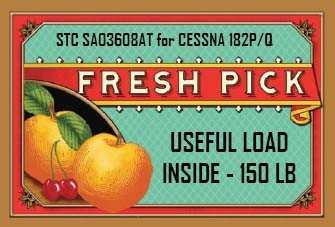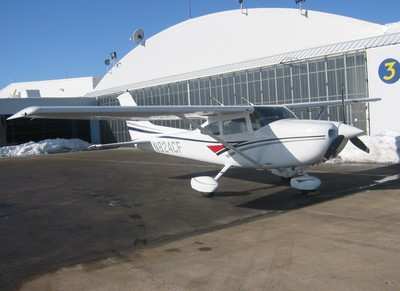Cheesy Name... But A Real Improvement In Usability
 Technically known as FAA
Supplemental Type Certificate SA03608AT, the "Fresh Pick" STC
increases the useful load of the Cessna 182P and 182Q model
airplanes manufactured from 1972 to 1980 by 150 to 160 pounds. And,
the STC does it with no labor, parts or installation costs. In many
cases, the airplane’s ramp weight increases by 160
pounds.
Technically known as FAA
Supplemental Type Certificate SA03608AT, the "Fresh Pick" STC
increases the useful load of the Cessna 182P and 182Q model
airplanes manufactured from 1972 to 1980 by 150 to 160 pounds. And,
the STC does it with no labor, parts or installation costs. In many
cases, the airplane’s ramp weight increases by 160
pounds.
Tom Storli, developer of the STC, says the rationale for it
goes back to 1956... when Cessna first certified the Cessna
182, and the maximum design gross weight (both landing and takeoff)
was 2550 pounds. The standard useful load was then just over 1000
pounds. As the years passed, gross design weights were
incrementally increased as changes were introduced to the basic 182
design.
When production of the new 182S model was finally restarted in
1996, the Maximum Gross Takeoff Weight (MGTOW) had grown to 3100
pounds, or a whopping 550 pounds above that of the first 182. And
yet, the standard useful load had increased by less than 200
pounds, to only 1200 pounds. This loss in useful load was caused by
increased empty weight due to the installation of more systems,
modern avionics and "must have" improvements.
All of the early Cessna 182s were certified to Part 3 of the US
Civil Air Regulations which originally prohibited a design landing
weight less than the MGTOW. Only some time after Cessna’s
type certificate was awarded did the CAA amend the regulations,
recognizing that the requirement had "restricted unduly the utility
of small airplanes."
At that point, Cessna was able to certify the 182N in 1970 with
a MGTOW of 2950 pounds, while keeping the landing weight at 2800
pounds. In 1981, Cessna did it again for the tubular gear 182R
models; MGTOW became 3100 pounds, while landing weight remained at
2950 pounds. These numbers, providing the greatest loading
flexibility, have been retained in all fixed-gear 182s to the
present day.
Cessna did not, however, retrofit the 182R MGTOW increase to the
structurally identical 182P and 182Q models.
"After all, those airplanes had already been sold,"
said Storli. "There was no technical reason for this omission,
and FAA certification for these models has now been granted via our
Fresh Pick STC."
"I know that Fresh Pick is an unusual name for an STC," Storli
added, "but these 182s are old airplanes, 28 to 36 years old, in
fact. There hasn’t been a new uncomplicated STC for these
1972 to 1980 models in quite some time, certainly not one requiring
this economical investment."
Storli added STC holders will enjoy "the widest CG envelope ever
available for any fixed-gear Cessna 182."

The STC requires no parts or installation labor, though it is
still considered a "major alteration" to the airplane under FAA
regulations. FAA demanded very thorough and validated engineering
compliance reports in the areas of performance, structures,
aerodynamic loads, maintenance, flight testing and acoustics, prior
to granting the STC.
"The old saw suggesting that no project may be approved until
the paperwork equals the weight of the airplane was very nearly
proven," Storli quipped.
 ANN's Daily Aero-Linx (04.17.24)
ANN's Daily Aero-Linx (04.17.24) ANN's Daily Aero-Term (04.17.24): Jamming
ANN's Daily Aero-Term (04.17.24): Jamming ANN's Daily Aero-Linx (04.18.24)
ANN's Daily Aero-Linx (04.18.24) Aero-News: Quote of the Day (04.18.24)
Aero-News: Quote of the Day (04.18.24) ANN's Daily Aero-Term (04.18.24): Hold-In-Lieu Of Procedure Turn
ANN's Daily Aero-Term (04.18.24): Hold-In-Lieu Of Procedure Turn




